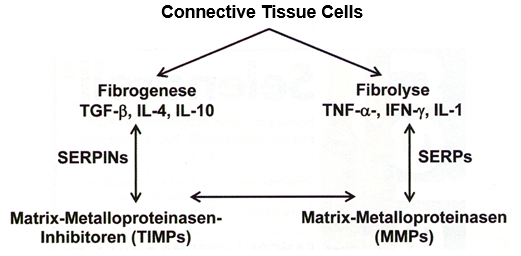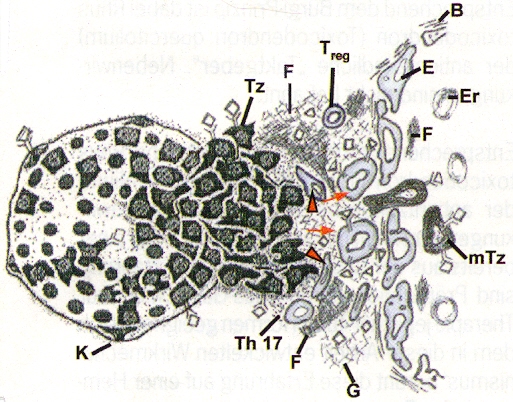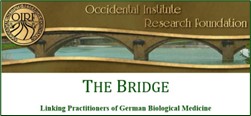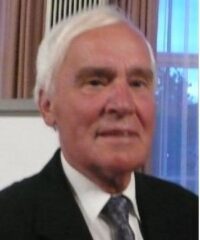The Bürgi Principle* is promising to use
and to combine Rhus Toxicodendron
(Toxicodendron quercifolium)
The regulation ability of our organism depends on the balance between proteolysis and protease inhibition. For examination of the actual state of tissue buildup and reduction in the dynamic equilibrium of the organism, a permanent subclinical inflammation readiness exists in the different tissues [Overview in 5, 6]. Tumors and chronic illnesses do not adhere to this: Where at first for its development and propagation the defense system has to “go blind”, at the last it overtaxes the immune system through autoimmune reactions. Since tumors also primarily need inflammation reactions for tissue rebuilding, from a therapeutic viewpoint it would be necessary to use “inflammation regulators” such as those available to biological medicine to use as preventive or adjuvant [8]. The goal of this work is to explore a mechanism of action for tumor inflammation, in particular focusing attention on the milieu, i.e. the ground substance, in which the tumor cells live.
The Dynamic Equilibrium of the Extracellular Matrix
Below the connective tissue cells there are above all the fibroblasts, which are “suitable to every situation” (influence epigenetic factors from the environment and within the body) and form the fibrillar components of the extracellular matrix or ground substance (proteoglycan / glycosaminoglycans [PG / GAGs], interlinking glycoproteins [among others fibronectin], collagen and elastin). Their rebuilding takes place across cytokine signals and leads to the formation of serine proteases (SERPs; among others plasmin) and their inhibitors (SERPINs; among others antiplasmin). SERPs again activate the “heavy” matrix-metalloproteinase (MMPs), which are balanced by the matrix-metalloproteinase inhibitors (TIMPs) (Figure 1).

Figure 1: Feedback between fibrogenesis and fibrolysis. IFN-γ interferon gamma; IL interleukin;
TGF-β Transforming Growth Factor Beta; TNF-α Tumor Necrosis Factor Alpha; SERPs serine protease;
SERPINs serine protease inhibitors; MMPs Matrix-Metalloproteinase; TIMPs Matrix-Metalloproteinase Inhibitors.
Cytokines, which promote fibrogenesis, are TGF-β (Transforming Growth Factor Beta) as well as the interleukins IL-4 and IL-10; those which maintain the fibrolysis are TNF-α (Tumor Necrosis Factor Alpha), IFN-γ (Interferon Gamma) and the interleukins IL-1 and IL-6. For prioritization TNF-α and TGF-β are the crucial ones, they are mutually regulating cytokines.
The principle that an activation immediately also initiates a counter-regulation, is typical for organisms. This is always taken into account in Biological Medicine with regulation therapies [Overview in 6].
The Meaning of Tumor Margin Inflammation
The primary development of a tumor proceeds up to a diameter of approximately 2mm in a delimited spheroid against the surrounding connective tissues. With further growth the cells can no longer be nourished through diffusion. The hypoxia activates the HIF-1 (Hypoxia Inducible Factor 1) in the tumor cells which stimulates all typical functions of a tumor cell, among others the aerobic glycolysis (“Warburg Effect”), cell division, oxygen radicals, the “Tumor Derived Colony Stimulation Factor 1” (CSF-1), dedifferentiation factor ID1 (Inhibitor of Differentiation 1) and the synthesis of vascular endothelial growth factors (VEGFs) with sprouting of capillaries, which in the end find connections with the blood and lymph vessels [4, 5]. On the basis of the Warburg Effect the HIF-1 is never switched off because the tumor cells always maintain the aerobic glycolysis even if they live in an oxygen rich milieu (e.g. in the blood and lungs) [3, 13].
While non-metastasized “benign” tumors grow with the connective tissue capsule, the malignant spheroid opens dependent on the attractive and compressive forces in the matrix (“mechanotransduction”). Along these forces fibroblasts and macrophages are induced to atypical “regulation behavior”. While the macrophages increasingly form TNF-α and proteolytic enzymes, hyaluronic acid is increasingly formed from fibroblasts. This reservoir is supplemented by the hyaluronic acid rich, proteolytic resulting acid fission products of PG / GAGs. Tumor cells which leave the primary tumor thus get into an acid ground substance conducive to tumor growth [Overview in 5, 6].
The most prominent event on the tumor growth front is the enslavement of all cells located there including the defensive cells to the tumor cells [13, 17]. Because on this occasion individual genetic factors play a big role, it becomes understandable why every tumor of the same histological type dies individually. At present, the concept of a personalized cancer treatment develops from this [1].
The central coagulation factor, the tissue factor, is also activated by the margin inflammation reaction. As a result the formation of tumor-typical fibrin precipitations occur (Figure 2). Nevertheless, these do not fully “mature” (polymerize) because the high levels in proteolytic enzymes that link up with and stabilize fibronectin as well as Factor XIII (fibrin stabilizing factor) are not available and are not formed at all by the tumor cells and their “slaves”. Therefore the tumor fibrin does not show any diagonal stripes, is unstable and wide-meshed. It is very well suited as storage for all tumor supporting cell products, has an effect on the mitogen and stimulates the vascular formation. Thus the tumor invasion and metastasization are speeded up [16]. On this occasion the enslaved macrophages play an important role: They migrate from the blood stream as inflammation producing macrophages (M1) while on their surface histiocytes develop the receptor for the epithelial growth factor (EGFR) as place-constant macrophages (M2). Because the tumor cells are expressed onto the surface of the EFG, they are taken from the M2 “piggyback” and brought to the blood and lymph capillaries, from where they accelerate their metastasizing ways [10, 12].

Figure 2: Schematic representation of the growth front of a tumor. Inflammation cells are found
in the margin area of migrating tumor cells (Tz) in the ground substance (G): macrophages (red arrows),
myofibroblasts (red arrow head), TH17 cells (Th17), regulatory T-lymphocytes (Treg),
basal membrane fragment (B), endothelium (E), erythrocyte (Er), tumor fibrin (F), collagen
tumor capsule (K), metastasized tumor cells (mTz). Triangles mark the Colony Stimulation
Factor 1 (CFS-1) with its receptor. Squares mark the epithelial growth factor (EGF) with its receptor.
Adjuvant Homeopathic Tumor Therapy
In homeopathy Rhus toxicodendron (Toxicodendron quercifolium) is considered as an important pain remedy [15, overview in 6]. In D3 to D8 potency Rhus tox. can completely contain inflammation processes. An inhibition of MMPs by Rhus tox. can be proven in vitro [9]. According to the Bürgi Principle [a combination of] substances potentize their effect, which causes the same functional change or removes the same illness symptoms, if they have different pharmacological weak points [2]. This can be achieved by a combination of Rhus tox. (D3) with four other inflammation specific homeopathics: Berberis vulgaris Ø, Solanum dulcamara D3, Ledum palustre Ø and Colchicum autumnale D4 (inTEH5®). The latter ones have an effect inhibiting the inflammation process in different ways [Overview in 18].
Therefore all the mentioned remedies together are subject to the Bürgi Principle.
As well Rhus tox. as the anti-inflammatory “draft horse” is thereby strengthen in its effect. Because of this a primary tumor can remain caught in its connective tissue membrane. The results with Rhus tox. (D6) on 14 “outpatient” tumor patients speak for this hypothesis. Correspondingly they reported about pain reduction, improvement of the general state of health and reduction of the psychosocial stresses (“salutogenic reaction”) [7], regardless of the preceding and additional treatments [11].
Behind this stands a general therapy principle whose common factor is inflammation inhibition. However the therapist must cautiously approach the individual circumstances by exact observation and documentation. Another advantage of the application of this combination is that pains and inflammatory illnesses of completely different genesis (e.g. rheumatic disorders) can be treated with it and at the same time a cancer prophylaxis is pursued.
Summary
The active substance combination represents a highly effective antiphlogistic.
Nevertheless, according to the Bürgi Principle Rhus toxicodendron (Toxicodendron quercifolium) is the anti-inflammatory “clock”. Side effects are unknown.
In accordance with experience already dating back to ancient times, preparations from Rhus plants are suitable to treat any tumor forms. According to the active mechanism developed in this work, this experience is based on an inhibition of tumor margin inflammation.
 An Exclusive Translated Article for Members
An Exclusive Translated Article for Members
From THE BRIDGE Newsletter of OIRF
Published September 2021
From an article in CO’MED, Nr. 03, 2012
Machine Translation by SYSTRAN, Lernout & Hauspie, LogoMedia & Promt
Translation & redaction by: Carolyn L. Winsor, OIRF
© Copyright 2012, Prof. Dr. Hartmut Heine, Neuhausen, Germany
Footnote
* Burgi’s principle, 1932: “The effect of two substances that lead to the same change in function or remove the same symptoms add up when they have the same – and potentiate when they have different – pharmacological target points”.
Burgi postulated that the simultaneous administration of different substances with a similar therapeutic action would create a synergetic effect that is more than the sum of the individual effects of all the single substances.
In antihomotoxic combination preparations, besides a complementary action of the different substances of the formula, the synergy of the components comes from Burgi’s principle.
Literature
- Bojar H, Poremba Ch, Krenn V: Neue Perspektiven in der personalisierten Krebsbehandlung. Die Naturheilkunde 2011; 88: 10-13
- Bürgi E: Die wissenschaftlichen Grundlagen der Kombinationstherapie. Abhandlungen über homöopathische Fragen. 1928; 4: 25-37
- Chiang AC, Massagué J: Molecular basis of metastasis. N Engl J Med. 2008; 359: 2814-24
- Hanahan D, Folkman J: Patterns and emerging mechanisms of the angiogenic switch during tumorigenesis. Cell 1996; 86: 353-364
- Heine H: Lehrbuch der biologischen Medizin. 3. Aufl. Stuttgart: Hippokrates 2006
- Heine H: Ist Rhus toxicodendron L. (Toxicodendron quercifolium Greene) in homöopathischer Aufbereitung zur adjuvanten Tumorbehandlung geeignet? Ein systemischer Review. Schweiz Zschr GanzheitsMedizin 2008; 20: 35- 40
- Heine H: Heine E. Befindensstörungen – Chronische Krankheiten – Altern. Hochheim: Edition CO’MED, 2009
- Heine H : Tumorentzündung und Metastasierung – Hemmung durch Rhus toxicodendron. Die Naturheilkunde (Forum Komplementäre Onkologie/lmmunologie) 2011; 88: 4-8
- Heine H, Andrä F: Hemmung von Tumor Matrix Metalloproteinasen durch rhus toxicodendron L. – eine in vitra Studie. Erfahrungsheilkunde 2004; 53: 193-208
- Lee JJ, Lotze MT: Molecular basis of metastasis. N Engl J Med, 2009; 360: 1689-93
- Pless H: Heilversuche mit Rhus toxicodendron L. (Rhus tox) zur adjuvanten Behandlung bei Tumorerkrankungen. CO’MED Fachmagazin (2008) 14: 20-212008
- Randolph GJ: No need to coax macrophages. 2011; 332: 1268-70
- Samoszuk M, Deng T, Hamamura MJ et al.: Increased blood clotting, microvascular density, and inflammation in eotoxin-secreting tumors implanted in mice, Am J Path 2004; 165: 449- 456
- Semenza GL: Oxigen sensing, homeostasis, and disesse. N Engl J Med. 2011; 365: 537-547
- Stephenson J: Homöopathische Krebsbehandlung, Zschr Klass Homöopathie 1959, 6: 273-277
- Stockschläder M, Wenzel F, Zotz RB, Scharf RE: Antikoagulation als onkologisches Therapieprinzip, Dtsch Med Wochenschr. 2005; 130: 220-225
- Varki A, Varki MN, Borsig L: Molecular basis of metastasis. N Engl J Med. 2009; 360: 1678- 89
- Wenigmann M: Phytotherapie, München: Urban & Fischer, 1999



